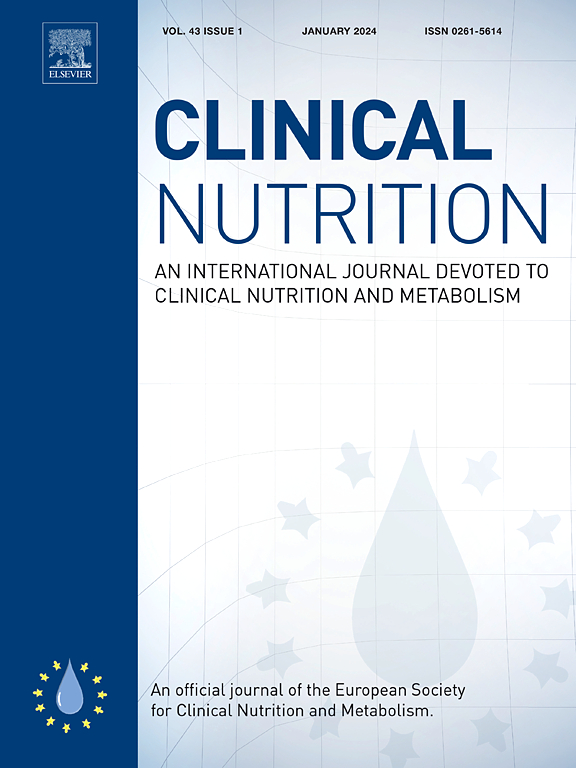能量过剩会促进健康年轻男性体内蛋白质的增加:随机临床试验
IF 6.6
2区 医学
Q1 NUTRITION & DIETETICS
引用次数: 0
摘要
背景& 目的热量过量喂养加上摄入充足的蛋白质,不仅会增加体脂质量,还会增加去脂质量。然而,过度喂养导致的去脂质量增加是否与体内蛋白质总量的增加有关,目前仍不清楚。在我们的随机对照试验中,23 名健康的年轻男性在为期 6 周的时间里摄入了与他们的能量需求相当的饮食,其中仅蛋白质就提供了 +10% 的能量盈余,或 +40% 的能量盈余(蛋白质 +10%,碳水化合物 +30%)。我们使用双能 X 射线吸收测定法、氘稀释法和水下静力学称重法,通过四室模型估算了人体总蛋白质质量。7% (0.44 kg; 95 % 置信区间[CI], 0.21-0.67 kg; P = 0.003);然而,10% 的能量盈余并没有带来显著变化 (0.00 kg; 95 % 置信区间[CI], -0.38-0.39 kg; P = 0.980)。干预持续时间(时间)与能量盈余(组别)之间存在明显的交互作用(P = 0.035,线性混合效应模型),不同组别之间身体蛋白质总量的增加有明显差异的趋势(P = 0.059,Wilcoxon 秩和检验)。结论在摄入过量蛋白质的健康男性中,较高的能量摄入可促进体内蛋白质质量的增加,这表明能量过剩在体内蛋白质积累中的重要性。试验注册该试验已在大学医院医学信息网临床试验注册中心注册,注册号为 UMIN000034158。本文章由计算机程序翻译,如有差异,请以英文原文为准。
Greater energy surplus promotes body protein accretion in healthy young men: A randomized clinical trial
Background & aims
Caloric overfeeding combined with adequate protein intake increases not only body fat mass but also fat-free mass. However, it remains unclear whether the increase in fat-free mass due to overfeeding is associated with an increase in total body protein mass. We evaluated the hypothesis that overfeeding would promote an increase in total body protein mass.
Methods
In our randomized controlled trial, 23 healthy young men were fed a diet equivalent to their energy requirements with a +10 % energy surplus from protein alone or a +40 % energy surplus (+10 % from protein, +30 % from carbohydrate) for 6 weeks. We estimated total body protein mass by a four-compartment model using dual-energy X-ray absorptiometry, deuterium dilution, and hydrostatic underwater weighing.
Results
The 40 % energy surplus over 6 weeks significantly increased body protein mass compared to baseline by 3.7 % (0.44 kg; 95 % confidence interval [CI], 0.21–0.67 kg; P = 0.003); however, the 10 % energy surplus did not result in a significant change (0.00 kg; 95 % CI, −0.38–0.39 kg; P = 0.980). A significant interaction between intervention duration (time) and energy surplus (group) was observed for total body protein mass (P = 0.035, linear mixed-effects model), with a trend toward a significant difference in total body protein mass gain between groups (P = 0.059, Wilcoxon rank sum test). The increase in body protein mass due to the energy surplus was correlated with an increase in fat mass (r = 0.820, p = 0.002).
Conclusions
A higher energy intake was found to promote an increase in body protein mass in healthy men consuming excess protein, suggesting the importance of energy surplus in body protein accumulation. This effect of energy surplus may be related to factors such as increased body fat mass and the associated secretion of adipokines.
Trial registration
The trial was registered with the University Hospital Medical Information Network Clinical Trial Registry as UMIN000034158.
求助全文
通过发布文献求助,成功后即可免费获取论文全文。
去求助
来源期刊

Clinical nutrition
医学-营养学
CiteScore
14.10
自引率
6.30%
发文量
356
审稿时长
28 days
期刊介绍:
Clinical Nutrition, the official journal of ESPEN, The European Society for Clinical Nutrition and Metabolism, is an international journal providing essential scientific information on nutritional and metabolic care and the relationship between nutrition and disease both in the setting of basic science and clinical practice. Published bi-monthly, each issue combines original articles and reviews providing an invaluable reference for any specialist concerned with these fields.
 求助内容:
求助内容: 应助结果提醒方式:
应助结果提醒方式:


